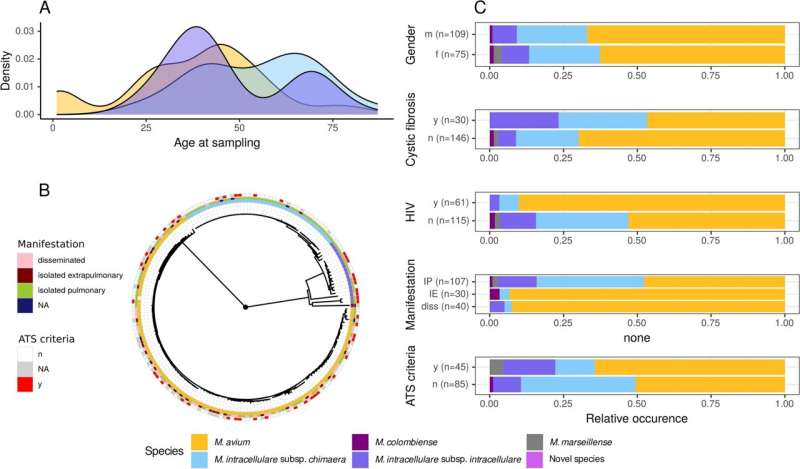This article has been reviewed according to Science X's editorial process and policies. Editors have highlighted the following attributes while ensuring the content's credibility:
fact-checked
peer-reviewed publication
proofread
Study unravels clinical, genomic characteristics of non-tuberculous mycobacteria in Europe

A multinational European study provides the first comprehensive clinical and genomic data on the Mycobacterium avium complex from continental Europe. The data reveal the population structure of this group of pathogens and indicate that plasmids play a significant role in their evolution and might contribute to resistance and virulence of these bacteria.
When discussing mycobacteria, people typically think of Mycobacterium tuberculosis, the causative agent of tuberculosis. However, more than 200 different bacteria of this genus occur in nature. To distinguish them from the tuberculosis pathogens, they are called non-tuberculous mycobacteria (NTM).
The most prevalent group of NTM causing clinically relevant disease in Europe is the so-called Mycobacterium avium complex (MAC). In most people, these bacteria do not cause disease but in immunocompromised or elderly people, but also in children, these NTMs can cause serious lung infections and inflammation of the lymph nodes.
In contrast to tuberculosis, where the numbers in Germany have been declining in recent years, the number of diseases caused by NTM has been steadily increasing over the last two decades. These pathogens have come into particular focus due to an outbreak in connection with devices used in heart operations. Contaminated devices resulted in the transmission of mycobacteria, which led to life-threatening infections.
Until now, little has been known about the genetic composition, disease-causing effects and transmission routes of the pathogens of the Mycobacterium avium complex.
In this new study, published in the journal Genome Medicine, the researchers provide the first comprehensive genomic and clinical data for the Mycobacterium avium complex from Germany and continental Europe.
Using whole genome sequencing (WGS), a total of 610 isolates from 465 patients from Germany, Switzerland and France were examined.
The scientists were able to show that M. avium is the most common isolated species from the MAC complex in these countries, followed by M. intracellulare subsp. chimaera and M. intracellulare subsp. intracellulare.
In addition, potentially new species have been identified based on sequencing data. As opposed to the outbreak strain from the heart operation devices, isolation of subsp. chimaera from this study population was less likely to be associated with clinically relevant disease.
"The populations structure analysis also revealed many clusters of closely related isolates, indicating transmission events. However, we believe that person-to-person spread is quite unlikely and that contact with environmental sources is the more probable transmission route," said Dr. ir. Margo Diricks and PD Dr. med. Nils Wetzstein, authors of the study from the Research Center Borstel, Leibniz Lung Center and the University Hospital Frankfurt.
The study also shows the presence of plasmids in a large proportion of MAC isolates in Europe, especially in subsp. chimaera, suggesting a significant evolutionary history and importance in these bacteria.
Plasmids are ring-shaped DNA structures that occur in many bacteria but are absent in Mycobacterium tuberculosis. They can reproduce independently in the cell and can play a role in transmitting virulence factors and resistance genes.
The authors suggest that future studies should prioritize investigating the predominant transmission routes for MAC and exploring the potential role of NTM plasmids in the spread of virulence and resistance.
More information: Nils Wetzstein et al, Clinical and genomic features of Mycobacterium avium complex: a multi-national European study, Genome Medicine (2024). DOI: 10.1186/s13073-024-01359-8



















